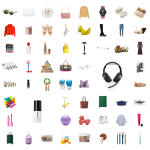
To morph into That Girl, there are a few things you must do. You should drink no less than three beverages in the morning, including but not limited to a matcha tea latte, hot lemon water, and a healthy smoothie. You need to work out before 9 a.m., preferably in a matching set. It would be best if you had a multi-step skincare routine that costs anywhere between $100 and $1,000. Then, the housekeeping: journaling, reading, meditating, and making your bed before you start the workday. In the evenings, That Girl goes through it all again: beverages, skincare, reading, and making a beautifully plated meal. And don’t forget to document this routine online for accountability.
It might seem like this is a trend that lifts users toward self-betterment. But in reality, it’s a tired, recycled aesthetic devised to turn us into the Best Workers we can be.
What are online aesthetics?
Aesthetics have existed for millennia. Ancient Greek philosophers like Plato, Aristotle, Plotinus, Socrates, and Xenophon all debated the ways art and beauty interact. Thousands of years later, their efforts were the basis for discussions led by philosophers like Alexander Gottlieb Baumgarten, who defined aesthetics as a younger sister of logic, and Arthur Schopenhauer, who argued that aesthetics should never be intertwined with politics or it would ruin the point of beauty. One of the most relevant descriptions of aesthetics was penned by Oscar Wilde, who wrote, « Aestheticism is a search after the signs of the beautiful, » and said that « by beautifying the outward aspects of life, one would beautify the inner ones. »
Wilde’s description of aesthetics might help us understand the drive behind collecting knickknacks and displaying them around our home, thoughtfully crafting flower arrangements in our kitchens, or curating a private art collection. But as the internet and social media took hold of society, this definition of aesthetics has morphed yet again, referring to how a subculture looks, posts, and feels online. In 2021, Vogue’s Sarah Spellings wrote that aesthetic « has evolved from an academic word and something utilized by artists and auteurs to something to categorize our own identities by. It can mean both personal style and a vague stand-in for beauty. » That same year, The Atlantic’s Kaitlin Tiffany wrote that the word had been entirely « divorced from its academic origins » after being thrust into the mainstream by Tumblr users in the early days of the platform. People use it as an adjective now, saying « that’s so aesthetic, » which actually means « that is aesthetically pleasing to me, » Tiffany points out. « In broader internet parlance, it now means a collection of signifiers or, more precisely, a ‘vibe.' »
Because of the cyclical nature of the internet, anything can be a « new » aesthetic. For instance, consider the clean girl aesthetic, which originally appeared on Black and brown women in the 1990s and included slicked-back buns, gold hoops, and glowing, hydrated skin. Recently, it’s been co-opted by white women like Hailey Bieber, and stands as an example of the biggest problems with so many of the most popular aesthetics online today: Instead of deepening the public’s understanding of an artistic movement, as aesthetics are meant to do, social media has pushed them to mostly become tired, racist, and classist capitalist ploys.
One of the most popular — and insidious — of these online aesthetics is a subculture of a variety of « productivity aesthetics. » And they happen to be total scams.
What are productivity aesthetics?
Online aesthetics dedicated to self-improvement run the gamut of controlling the diet, exercise, sleep, hygiene, and attitude of the people who post within them. People take gym selfies and write about #CleanEating and being #BuiltDifferent; they spend hours in the office after work because they’re a #Feminist #GirlBoss; or they devote their entire online selves to strive for perfection in the name of becoming #ThatGirl.
Each of these different variations of productivity aesthetics push people to improve themselves for their own well-being in spite of a society that burns us out. By doing so, they’re actually pushing people to better maintain the capitalist status quo of society. That’s the scam part: The aesthetic trend actually serves the very society that has burned us out.
Some of the habits these productivity aesthetics push users to emulate actually are good for you. Eating well and exercising and journaling and meditation have all been proven to be effective forms of self-care. But doing so with the intention of increasing your productivity will only lead you deeper into the hole you’re trying to dig yourself out of. And attempting to replicate the performative aesthetics of creators who promote aspirational lifestyles that are often not attainable can take a toll on the mental health of users and consumers, with detrimental effects on our psyches.
The aesthetic trend actually serves the very society that has burned us out.
In Wellness TikTok: Morning Routines, Eating Well, and Getting Ready to Be « That Girl, » author Katlin Marisol Sweeney-Romero argues that this form of aspirational content « ascribes to white supremacist views of beauty and productivity by idealizing the ‘look’ of wellness as that of a woman who is laboring at all times — for her job and for her body — and who is young, white or white-passing, thin, able-bodied, cisgender, and whose gender performance abides by heteronormative expectations of femininity. »
TikTok user @c.a.i.t.l.y.n did a Marxist reading of That Girl and 5 to 9 — a trend in which influencers detail the work they do in the hours before and after their jobs — at their online height. She references David Harvey’s book, A Companion to Marx’s Capital, which says that time is a social construct molded in relation to the work week, and points out that these trends are built around productivity and « maximizing your potential as both a worker and a consumer under capitalism. »
« [Think] about the ways that we use our time, even outside of the workplace, to serve the purposes of the workplace [and to prepare] ourselves to be better performers when we are at work,” she adds, pointing to how we try to optimize our commutes and work preparation by listening to podcasts about our jobs or reviewing work on our way home. « We have developed aesthetics and trends around producing productivity. »
Stephanie Alice Baker, a senior lecturer in sociology at the City University of London, told Mashable that this isn’t a new approach to self-betterment.
« The technologies change, the technologies evolve, but there is still this underlying impulse towards self-improvement, and it is always self-improvement in relation to the system in which it operates as opposed to an isolated individual trying to be their best self, » Baker said.
Because of its intrinsic connection to our society, productivity aesthetics seem to be primarily heralded by the people who have the time, money, and ability to set their life up in an aesthetically pleasing productive way: upper-class white people. But they don’t always appear to discriminate against gender.
Gendered elements of productivity aesthetics
The results you get from searching #discipline on Instagram and searching #5to9 are virtually the exact same with one exception — men flood the discipline hashtag with videos of their workouts, while women flood the 5to9 hashtag with their own. Same thing, different label.
Baker has done some research on gender display on Instagram, focusing on the fit fam aesthetic (in which users post muscled gym photos and inspirational quotes) and the clean eating culture online. She found that since it’s not as culturally acceptable to admit to wanting to lose weight, these accounts are instead framed in terms of health and wellness. And, through her work, she’s discovered that the performances on Instagram around diet culture were « predominantly male. »
« I think on the surface, most people would presume this is a very female aesthetic, » Baker told Mashable. « But actually what we found in that research is that predominantly the people who were using these clean eating hashtags and having the most popular posts were actually males. And it was just a different aesthetic. It was much more framed in this muscular male health orientation. »
Who is « That Girl? »
But when we look at productivity aesthetics, there is one that’s inherently gendered: the That Girl aesthetic. That Girl is a person who works out, journals, reads, cleans, and eats a healthy meal before their day job even begins. There are more than 7.1 billion views on the #ThatGirl hashtag on TikTok and over 838,000 posts under the #ThatGirl hashtag on Instagram. The That Girl aesthetic been universally criticized for promoting hustle culture, fatphobia, classism, and general toxicity. But even as That Girl dissolves, it won’t entirely disappear: It will reappear as the same ethos wrapped up in an entirely new package.
Society is always looking for ways to encourage people to perfect themselves. Before we had That Girl, we had the Girl Boss era. Long before we had the Girl Boss era, we had the 1861 classic Mrs. Beeton’s Book of Household Management by Isabella Beeton. We are in a perpetual cycle of girl boss-ification, now reshaped as productivity aesthetics online. Energy is neither created nor destroyed.
« As long as what we find valuable — a.k.a., expendable labor — is the constant that’s underlying what we find beautiful, then I think things are just gonna not be too different from each other, even though the tiny applications are different, » Hannah Kim, a professor of philosophy at Macalester College and member of the American Society for Aesthetics, told Mashable. We’ll do anything to be better at our jobs, including changing the way we look, talk, and lead our lives.
Baker adds that these goals may « seem like very much individual pursuits » but tend to actually rely on « the broader system in which they’re operating, » be that capitalism or the patriarchy. The That Girl aesthetic hinges itself upon self-betterment. Multiple videos describing how to be That Girl revolve around doing things that work specifically for you and your life — as long as the end goal is congruent with the life That Girl has. It lacks all individuality. And that may be by design.
« Aesthetics are not just this individual thing, it’s a societally embedded signaling, even for It Girls. An It Girl would be nothing if it weren’t for all the people who want to be her. It needs that embedding, and it’s reliant on that, » Kim said.
Why now?
There is something specific about our time and place in the world that makes these productivity aesthetics such incredibly insidious scams. The wealth gap is deepening, a recession is looming, and we’re lonelier than ever, which forces us to seek community wherever we can find it.
There has been a massive shift in how Americans commune together over the past few decades. Membership has been steadily falling in everything from church groups and school associations to labor unions and Greek organizations, according to a 2019 congressional report. The Joint Economic Committee report found that membership rates in some organizations fell from 75 percent in 1974 to 62 percent in 2004.
« When you don’t have these religious structures, which are guiding you and defining who you ought to be, what ends up happening is people still seek meaning, » Baker said. « You still need somebody to give them this sense of purpose. And so this is where you often find a lot of celebrities or influencers filling this void. »
Moreover, aesthetic trends online tend to morph at a quicker pace than they do in real life, in part because aesthetics reach people faster than ever before. Girl Boss was replaced by That Girl. That Girl is being replaced by the 9-to-5 girlies. We are in a perpetual cycle of productivity aesthetics.
« As more and more people get access to the same idea, they’re going to have quicker pushbacks or quicker developments or quicker add-ons, » Kim said. « So I’m not surprised at all that, especially for a platform with such heavy users like TikTok, these aesthetics would be constantly changing. »
Arlie Hochschild, a writer who coined the phrase « second shift » to refer to the household and childcare duties that people (primarily women) shoulder before and after the workday, also spoke about how our relationship to our own representation of self affects our actual sense of self. She says the more we work on ourselves to become comfortable with representing an emotion we think we ought to feel, the more inauthentic the emotions we are trying to embody become. Ultimately, we find ourselves getting further away from our real selves.
The answer here isn’t to stop doing things that make you feel good, but perhaps to be more aware of why you’re doing them. Are you journaling in order to emulate an online trend and post it on Instagram Stories, or are you journaling because it makes you feel better and more connected to yourself? Awareness over our actions is needed when we’re constantly being pulled into a world not of our own creation, but one fueled by the will of tech companies and capitalism, pushing a productivity aesthetic that’s not actually productive.





